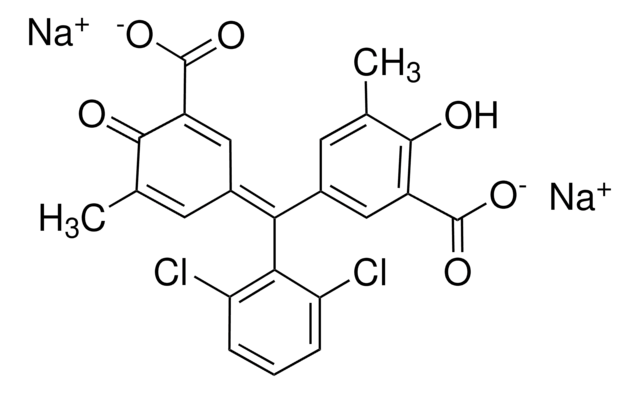199532
Chromeazurol S
Dye content 45 %
Synonym(s):
Chrome Azurol S, Mordant Blue 29
About This Item
Recommended Products
form
powder
Quality Level
composition
Dye content, 45%
technique(s)
microbe id | staining: suitable
color
dark brown
solubility
water: 0.1%
λmax
458 nm
ε (extinction coefficient)
≥9000 at 424-436 nm in H2O at 0.03 g/L
≥9000 at 424-436 nm in H2O
application(s)
diagnostic assay manufacturing
hematology
histology
storage temp.
room temp
SMILES string
[Na+].[Na+].[Na+].Cc1cc(cc(C([O-])=O)c1O)C(=C2/C=C(C)C(=O)C(=C2)C([O-])=O)\c3c(Cl)ccc(c3Cl)S([O-])(=O)=O
InChI
1S/C23H16Cl2O9S.3Na/c1-9-5-11(7-13(20(9)26)22(28)29)17(12-6-10(2)21(27)14(8-12)23(30)31)18-15(24)3-4-16(19(18)25)35(32,33)34;;;/h3-8,26H,1-2H3,(H,28,29)(H,30,31)(H,32,33,34);;;/q;3*+1/p-3/b17-12-;;;
InChI key
FUIZKNBTOOKONL-NDOZRWCBSA-K
Looking for similar products? Visit Product Comparison Guide
Related Categories
General description
Application
Storage Class Code
11 - Combustible Solids
WGK
WGK 3
Flash Point(F)
Not applicable
Flash Point(C)
Not applicable
Personal Protective Equipment
Choose from one of the most recent versions:
Already Own This Product?
Find documentation for the products that you have recently purchased in the Document Library.
Our team of scientists has experience in all areas of research including Life Science, Material Science, Chemical Synthesis, Chromatography, Analytical and many others.
Contact Technical Service





